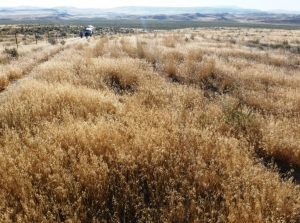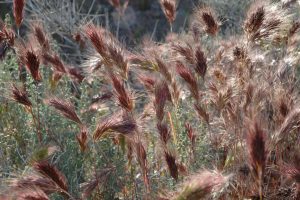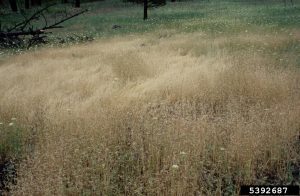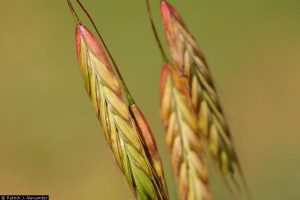Invasive annual grasses
The following invasive annual grasses are dominating millions of acres in the Great Basin. Their dominance comes at the expense of native vegetation and valuable forage. These species are also largely responsible for increased fire frequency, which has limited sagebrush regeneration and thus negatively impacted wildlife habitat.

Cheatgrass (Bromus tectorum) is an aggressive and successful winter annual in the Great Basin, where there are no native winter annuals. This novel growth habit allows cheatgrass to exploit moisture and resources before native vegetation is growing in early spring. This crowds out native vegetation and has created a continuity of fuels that did not exist previously in native Great Basin grass and shrublands. Cheatgrass creates a highly flammable landscape from late spring through early fall.
Cheatgrass provides good quality livestock forage early in the season (late winter-early spring), but mature plants are unpalatable.

Medusahead (Taeniatherum caput-medusae) is another winter annual that has invaded the Great Basin. It matures 2 to 4 weeks later than cheatgrass and replaces cheatgrass at sites where soil moisture remains after cheatgrass has matured. Medusahead biomass is high in silica, highly flammable, and degrades slowly, which can fuel large, fast-moving wildfires. Soil-stored medusahead seed often survives rapidly spreading fires, which promotes post-fire establishment and dominance.
Medusahead is only grazed by livestock when it is vegetative. This provides a narrow window for control using livestock. However, this window can piggyback that of cheatgrass at sites where these species co-occur.

Ventenata (Ventenata dubia) is also a winter annual. It germinates in the fall and produces seed in May and June. Ventenata is beginning to replace perennial grasses and forbs in Great Basin rangelands. It produces a shallow root system, which can promote soil erosion as ventenata becomes more dominant.
Ventenata is used by livestock in early spring but is avoided once flowers are being produced. At this point, stems harden and are unpalatable. However, ventenata seed viability lasts only 2 to 3 years suggesting that 3 to 4 years of intensive management and vigilant monitoring may provide control.

Field brome (Bromus arvensis) is yet another problematic winter annual in the Great Basin. Field brome, like its cheatgrass relative, is an aggressive species that can out-compete native species for moisture and soil nutrients, especially nitrogen. As a heavy nitrogen feeder it can be especially problematic following fire.
Field brome is utilized by livestock before it mature and produces seed. Although not as problematic as cheatgrass in the Great Basin, this may change with a warming climate.

